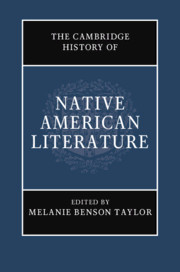Book contents
- The Cambridge History of Native American Literature
- The Cambridge History of Native American Literature
- Copyright page
- Contents
- Figures
- Contributors
- Introduction: What Was Native American Literature?
- Part I Traces and Removals (Pre-1870s)
- Part II Assimilation and Modernity (1879–1967)
- Part III Native American Renaissance (Post-1960s)
- 14 Rethinking the Native American Renaissance: Texts and Contexts
- 15 Marginally Mainstream: Momaday, Silko, Erdrich, and Alexie
- 16 Indigenous Lives, Visual Autobiographies
- 17 Indigenous Writing in Canada
- 18 Reservation Realities and Myths in American Literary History
- 19 Mapping the Future: Indigenous Feminism
- 20 Queer Sovereignty
- 21 Contemporary Indigenous American Poetry
- 22 Contemporary Native North American Drama
- Part IV Visions and Revisions: 21st-Century Prospects
- Index
- References
17 - Indigenous Writing in Canada
from Part III - Native American Renaissance (Post-1960s)
Published online by Cambridge University Press: 18 September 2020
- The Cambridge History of Native American Literature
- The Cambridge History of Native American Literature
- Copyright page
- Contents
- Figures
- Contributors
- Introduction: What Was Native American Literature?
- Part I Traces and Removals (Pre-1870s)
- Part II Assimilation and Modernity (1879–1967)
- Part III Native American Renaissance (Post-1960s)
- 14 Rethinking the Native American Renaissance: Texts and Contexts
- 15 Marginally Mainstream: Momaday, Silko, Erdrich, and Alexie
- 16 Indigenous Lives, Visual Autobiographies
- 17 Indigenous Writing in Canada
- 18 Reservation Realities and Myths in American Literary History
- 19 Mapping the Future: Indigenous Feminism
- 20 Queer Sovereignty
- 21 Contemporary Indigenous American Poetry
- 22 Contemporary Native North American Drama
- Part IV Visions and Revisions: 21st-Century Prospects
- Index
- References
Summary
For much of the twentieth century, Indigenous writers faced daunting barriers in getting their books published; indeed, lack of access, delays in publishing, inadequate distribution, institutional racism, and precarious archiving practices have shaped the history of Indigenous writing in Canada. The obstacles to publishing reflect a larger reality in which the forces of appropriation continue to attempt to dispossess Indigenous people of lands, languages, communities, and families. Particularly since the 1990s, Indigenous writers have used strategies of reframing and de-framing in order to bring stories that have been overlooked back into circulation, and to tell new stories outside of the ever-adapting box of what is expected as “Indigenous literature.” Writers shift the frame to make stories more legible—or in some cases, to deliberately foreground silence and what is not (yet) told. This struggle to re-frame, de-frame, and shatter the existing frames of stories have opened up new spaces of freedom in Indigenous literary expression.
Keywords
- Type
- Chapter
- Information
- The Cambridge History of Native American Literature , pp. 327 - 348Publisher: Cambridge University PressPrint publication year: 2020



